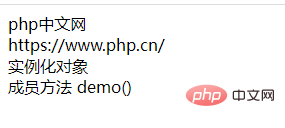What are the methods or attributes of the php object?
In PHP objects, methods refer to functions created in the class structure, which implement a behavior in the class and are part of the class; while attributes refer to variables directly declared in the class structure, in the object There can be multiple attributes, and each variable stores different attribute information of the object.

The operating environment of this tutorial: windows7 system, PHP7.1 version, DELL G3 computer
First of all, let’s briefly understand the related concepts:
Class: class is the outermost structure that defines the object-oriented subject. It is also used to wrap the subject data and functions (functions). A class is a type of common affairs. Representative represents the commonality of affairs.
Object: Object is a specific representative of a certain type of transaction and a specific unit of actual data and functional operations. It is also called an instance.
Instantiation: new, the process of obtaining a specific instance that conforms to the abstract concept from an abstract concept.
##Class members: member refers to all the contents in the class structure. There are three types of class members;
-
Method: Method is essentially a function created in the class structure, also called a member method, or member function.
Property: Property is essentially a variable created in the class structure, also called a member variable.
Member attributes
Variables declared directly in a class are called member attributes (can also be called member variables). Multiple variables can be declared in a class, that is There can be multiple member attributes in an object, and each variable stores different attribute information of the object. The syntax format is as follows:访问权限修饰符 属性名称 = 属性值;
- public: public, can be used inside the class, in subclasses, or outside the class , unrestricted;
- protected: protected, can be used inside the class and subclasses, but cannot be used outside the class;
- private: Private, can only be used inside the class, and cannot be used outside the class or in subclasses.
<?php
class Students{
var $name;
public $age;
private $sex;
public static $school;
}
?>Member methods
Functions defined in a class are called member methods. The only difference between functions and member methods is that functions implement an independent function, while member methods implement a behavior in the class and are part of the class. You can declare multiple member methods in a class. The declaration of member methods is exactly the same as the declaration of functions. However, when declaring member methods, you can add some access modifiers in front of the function keyword to control access. Permissions, such as public, private, protected, etc. Another thing to note is that the declared member methods must be related to the class and cannot be some meaningless operations. For example, when declaring the student class, if you declare the "flying" member method, every student instantiated can fly. This is a design error. [Example] Create some member methods in the Students class created in the above example.<?php
class Students{
var $name;
public $age;
private $sex;
public static $school;
public function Write(){
}
protected static function Read(){
}
function Listen(){
}
}
?>[权限修饰符] function 方法名 (类型 参数1, 类型 参数2, ..., 类型 参数n) : 返回值类型 {
... ...
}<?php
class Students{
var $name;
public $age;
private $sex;
public static $school;
public function Write(string $a, int $b):bool{
}
protected static function Read(string $str):int{
}
function Listen(int $num):bool{
}
}
?>Instantiate the object and access the members in the object
变量名 = new 类名(参数); //实例化一个类 变量名 -> 成员属性 = 值; //为成员属性赋值 变量名 -> 成员属性; //直接获取成员属性的值 变量名 -> 成员方法(); //访问对象中的成员方法
下面通过一个示例来演示一下:
<?php
header("Content-type:text/html;charset=utf-8");
class Website{
public $name, $url, $title;
public function demo(){
echo '成员方法 demo()';
}
}
$student = new Website();
$student -> name = 'php中文网';
$student -> url = 'https://www.php.cn/';
$student -> title = '实例化对象';
echo $student -> name.'<br>';
echo $student -> url.'<br>';
echo $student -> title.'<br>';
$student -> demo();
?>
推荐学习:《PHP视频教程》
The above is the detailed content of What are the methods or attributes of the php object?. For more information, please follow other related articles on the PHP Chinese website!

Hot AI Tools

Undresser.AI Undress
AI-powered app for creating realistic nude photos

AI Clothes Remover
Online AI tool for removing clothes from photos.

Undress AI Tool
Undress images for free

Clothoff.io
AI clothes remover

AI Hentai Generator
Generate AI Hentai for free.

Hot Article

Hot Tools

Notepad++7.3.1
Easy-to-use and free code editor

SublimeText3 Chinese version
Chinese version, very easy to use

Zend Studio 13.0.1
Powerful PHP integrated development environment

Dreamweaver CS6
Visual web development tools

SublimeText3 Mac version
God-level code editing software (SublimeText3)

Hot Topics
 1386
1386
 52
52
 PHP 8.4 Installation and Upgrade guide for Ubuntu and Debian
Dec 24, 2024 pm 04:42 PM
PHP 8.4 Installation and Upgrade guide for Ubuntu and Debian
Dec 24, 2024 pm 04:42 PM
PHP 8.4 brings several new features, security improvements, and performance improvements with healthy amounts of feature deprecations and removals. This guide explains how to install PHP 8.4 or upgrade to PHP 8.4 on Ubuntu, Debian, or their derivati
 How To Set Up Visual Studio Code (VS Code) for PHP Development
Dec 20, 2024 am 11:31 AM
How To Set Up Visual Studio Code (VS Code) for PHP Development
Dec 20, 2024 am 11:31 AM
Visual Studio Code, also known as VS Code, is a free source code editor — or integrated development environment (IDE) — available for all major operating systems. With a large collection of extensions for many programming languages, VS Code can be c
 7 PHP Functions I Regret I Didn't Know Before
Nov 13, 2024 am 09:42 AM
7 PHP Functions I Regret I Didn't Know Before
Nov 13, 2024 am 09:42 AM
If you are an experienced PHP developer, you might have the feeling that you’ve been there and done that already.You have developed a significant number of applications, debugged millions of lines of code, and tweaked a bunch of scripts to achieve op
 How do you parse and process HTML/XML in PHP?
Feb 07, 2025 am 11:57 AM
How do you parse and process HTML/XML in PHP?
Feb 07, 2025 am 11:57 AM
This tutorial demonstrates how to efficiently process XML documents using PHP. XML (eXtensible Markup Language) is a versatile text-based markup language designed for both human readability and machine parsing. It's commonly used for data storage an
 Explain JSON Web Tokens (JWT) and their use case in PHP APIs.
Apr 05, 2025 am 12:04 AM
Explain JSON Web Tokens (JWT) and their use case in PHP APIs.
Apr 05, 2025 am 12:04 AM
JWT is an open standard based on JSON, used to securely transmit information between parties, mainly for identity authentication and information exchange. 1. JWT consists of three parts: Header, Payload and Signature. 2. The working principle of JWT includes three steps: generating JWT, verifying JWT and parsing Payload. 3. When using JWT for authentication in PHP, JWT can be generated and verified, and user role and permission information can be included in advanced usage. 4. Common errors include signature verification failure, token expiration, and payload oversized. Debugging skills include using debugging tools and logging. 5. Performance optimization and best practices include using appropriate signature algorithms, setting validity periods reasonably,
 PHP Program to Count Vowels in a String
Feb 07, 2025 pm 12:12 PM
PHP Program to Count Vowels in a String
Feb 07, 2025 pm 12:12 PM
A string is a sequence of characters, including letters, numbers, and symbols. This tutorial will learn how to calculate the number of vowels in a given string in PHP using different methods. The vowels in English are a, e, i, o, u, and they can be uppercase or lowercase. What is a vowel? Vowels are alphabetic characters that represent a specific pronunciation. There are five vowels in English, including uppercase and lowercase: a, e, i, o, u Example 1 Input: String = "Tutorialspoint" Output: 6 explain The vowels in the string "Tutorialspoint" are u, o, i, a, o, i. There are 6 yuan in total
 Explain late static binding in PHP (static::).
Apr 03, 2025 am 12:04 AM
Explain late static binding in PHP (static::).
Apr 03, 2025 am 12:04 AM
Static binding (static::) implements late static binding (LSB) in PHP, allowing calling classes to be referenced in static contexts rather than defining classes. 1) The parsing process is performed at runtime, 2) Look up the call class in the inheritance relationship, 3) It may bring performance overhead.
 What are PHP magic methods (__construct, __destruct, __call, __get, __set, etc.) and provide use cases?
Apr 03, 2025 am 12:03 AM
What are PHP magic methods (__construct, __destruct, __call, __get, __set, etc.) and provide use cases?
Apr 03, 2025 am 12:03 AM
What are the magic methods of PHP? PHP's magic methods include: 1.\_\_construct, used to initialize objects; 2.\_\_destruct, used to clean up resources; 3.\_\_call, handle non-existent method calls; 4.\_\_get, implement dynamic attribute access; 5.\_\_set, implement dynamic attribute settings. These methods are automatically called in certain situations, improving code flexibility and efficiency.




